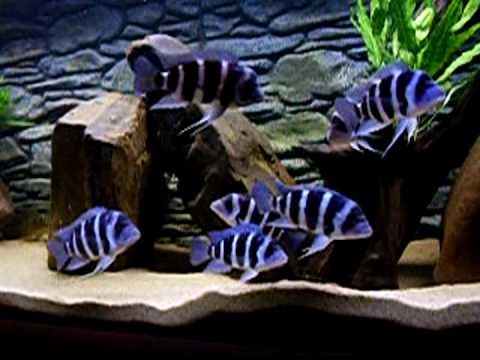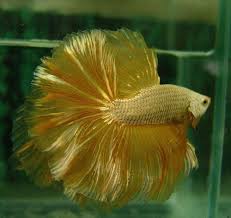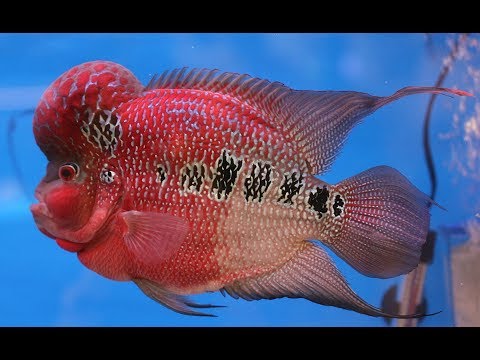The Frontosa Aquarium
7 years ago admin 0
The Frontosa
The Cyphotilapia, otherwise known as the Frontosa, are one of the most renowned african cichlids. As aquarists, we love it’s peaceful behavior and can’t help but be intrigued by the special shape. For years the Frontosa has been the emblem of my local fish store.
Today we will be talking about the Frontosa. On top of being easy to draw with a familiar shape it’s also fish that put us on the map. We started breeding our Moba Zaïres years ago and for a long time were the only ones to have Blue Zaïre Frontosas. We are also the only store that has a constant breeding colony. Meaning that I’m the only one who constantly has Blue Zaïre Frontosa for sale which let’s face it it’s pretty good for business.
It’s also nice is that when we moved into this store in 2011 all the breeding came in the same spot as the store. So to our clients who asked kindly enough we can bring them to the back and show them our breeding colony. So they see the parents of their fish Cyphotilapiais the genus name of the Frontosa, an african cichlid from Lake Tanganyika.

Frontosa species
There are three species in this genus . there’s a Cyphotilapia Frontosa, Cyphotilapia gibberosa and the Cyphotilapia sp North. Initially only the first species was described so they thought that all Cyphotilapia were Cyphotilapia Frontosa. Eventually when they separated the genus into more species then came the gibberosa and the SP North. Despite these new names the name Frontosa stuck, meaning that it became the common name for this fish. It’s so easy to remember and to say especially for us French speakers. The first part of the word “front” in French is “front” (said with french accent), which actually means forehead.
That’s literally how we recognize this fish with their forehead so we’ve got it pretty easy. This fish’s most prominent characteristic is its role or its forehead. Especially the hump on it which is an extension of their dorsal muscles. You can’t talk about Frontosa without talking about the hump. The frontosa’s hump can take years to grow. It comes with age and strength. So be patient if your fish didn’t develop it yet. In a tank with mature Frontosa, the hump of the dominant male will be a lot bigger than the dominated males and the female but don’t be fooled. The females also have a hump on their head.
Changes in maturity
With age the fins become long and string and they go up to his tail. This means that they’re not compatible with algae grazing cichlids, such as Mbunas that will eat those fins up. The colors will vary depending on where they’re from. Blue to black and yellow, the dominant males will also be a lot darker than the dominated ones. When a frontosa is mature sometimes you’ll see all the cichlids have one color, but the dominant male wILL sport another, usually a darker color. I’ve already seen some Cyphotilapia sp.North Burundis that are completely black. They were amazing. This one I just mentioned is black and white and they also have a little bit of brassy tint in the dorsal fin.
So the blue Zaïre. Zaïre is the old name for the Democratic Republic of Congo. Those are usually, well they’re black and white but with like a blue overlay. Most seven stripe frontosa, the Cyphotilapia frontosa, have some yellow in them. Another frontosa we see is the red frontosa or the copper band frontosa, of its other name. I have got some recently and showcase them. This is a line bred variety of the Cyphotilapia sp North Burundi. It’s not a hybrid but it has been bred in order to bring out that red color. It is not found in the wild and can be a little bit more aggressive than its blue yellow and black counterparts.
Length and lifespan
The Frontosa is one of the biggest African cichlids that is kept in the Hobby. The male Frontosa can grow up to 15 inches in length. The females will stay a lot smaller between 8 and 10 inches in length. This fish live up to 20 years in the aquarium. They will be your living room companion for many years so make sure you give them a good home. This fish is endemic to Lake Tanganyika meaning that it can only be found in this Lake. It is found throughout the lake. The Frontosa live in the deep waters of Lake Tanganyika. You can find them between 65 to 100 feet deep The Cyphotilapia gibberosa blue Zaïre, the one from the Congo, has been reported at 200 feet deep.

To bring these fish up safely requires more technique and more equipment than the shallow water cichlids. On the contrary the Cyphotilapia SP North from Kavala is one of the first frontosa that was brought into the hobby, and are usually fished around 16 feet deep. In the wild they live in caves at the bottom of the lake and are not at all territorial. In the aquarium make sure there are enough big cage structures. The colony will always swim around the dominant male.
The breeding aquarium
In my breeding aquarium I set up two caves contraptions one at each side of the aquarium. The dominant male and his harem will stay on one side. On the other side I have a dominated male who stays there. He knows this place since this is an aquarium which is an artificial reconstruction of an environment. My dominant male Frontosa stays in his spot. He will not fight for his spot but the others don’t try to take it from him. Sometimes if they’re scared or surprised they’ll even go swim with him and he doesn’t really mind if his females come to stick next to him.
You can put artificial plants or anubias plants which are natural plants in your aquarium. This last one is the only one that will thrive in our water parameters. They will dig them up so make sure that your plants are well tied to some rocks if you want to keep them. Even though in the wild they do not live among the plants, it’s still nice to have them in the aquarium especially for us as a decoration and it doesn’t hurt the fish. The fry will also hide in the artificial plant and will come out when they’re big enough. For substrate use pH augmenting substrate. I hope you’re not too picky on how you like your substrate because they are and they will move it around to their liking.
Frontosa habitat
A giant fish, the Frontosa is okay in a small aquarium. Small means 125 gallons or more. There are other giant cichlids who need a much bigger tank and are seldom kept. I know many aquarists who have kept Frontosa in a 90 gallon aquarium but I do not recommend it. It’s not ideal for this fish. Lake Tanganyika water parameters are very different from those of our local tap sources. This means that we have to adjust our water accordingly using products found at your local fish store. For nitrate keep it below 20 ppm for nitrate and ammonia 0 ppm, pH 8. 2 to 8. 4, GH 300 ppm and up KH 240 ppm temperature 79 degrees. For the temperature stability is key. If you can’t keep it below 84 well then keep it stable at 84. Huge variations can cause a lot of illness and fish such as the ich.
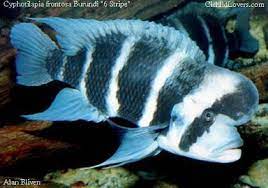
In the wild juvenile Frontosa feed off of crustaceans. the adults are piscivores meaning that they eat fish. Although they eat fish they are very bad and slow hunters. Their main source of food is another fish that is very popular in the hobby it’s the Cyprichromis. The Frontosa spend their day leisurely swimming below the schools of Cyprichromis. At dusk when the Cyprichromis go down to rest that’s when the Frontosa feast because they’re a lot slower and have come in their house. They will then wake up at dawn to feed before they go up and start swimming around again. You know what they say. The early bird gets the worm, especially if the bird is too slow to hunt during the day.
Frontosa Diet in the aquarium
In the aquarium feed your Frontosa carnivore pellets in the morning and omnivore or carnivore flakes at night. Once a week feed them frozen Krill or Mysisas they ate when they were juveniles. It reminds him of a simpler time on top of being a great addition to their diet. Don’t bother trying to feed them feeder fish they are bad hunters and will just end up living alongside the feeder fish if they can adapt to the pH.
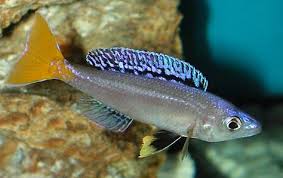
Breeding Frontosa
Frontosa are mouth brooders, meaning that like all Lake Malawi cichlids the female holds her fish in her mouth. For up to five weeks she will not eat. During this time don’t worry though; she’s made for this. If your female is holding do not isolate her. Frontosa breed a lot later in life, meaning that they’re usually already pretty big if you put a big fish in a in a small breathing box the lack of water circulation and of movement can be very dangerous for their health. Just let them swim around in the aquarium and the parents will protect their Fry, well most of them at least. Contrary to the Malawi cichlids Frontosa don’t dance to breed and they do not defend a territory when the time comes.
Frontosa breeding behavior
Unfortunately I don’t have a video of this. Mine usually do it at night and I frankly never caught them in the act so the consenting couple will just waddle their way away from the colony and the female will drop her eggs and while the male fertilizes them in front of each other and the female will back up in order to take them with her mouth and then they will continue again. On the contrary to Malawi cichlids who do a dance in circles Frontosa as I said earlier, are a colony fish. Keep them in schools of five or more in order to see their natural behavior. I am aware that many aquarists have had success with smaller than schools of five. Even though it works it’s not ideal and my suggestions are how to create the ideal african cichlid tank.
In the Frontosa aquarium you will keep a school of five or more Frontosa and that’s it. Of course if you’re planning on only keeping this fish I can’t imagine keeping only five. please don’t notice I only have five fish in my breeding colony, do as I say not as I do this is the best aquarium for breeding because they don’t have any other fish bothering them. Because they’re not territorial they might miss out on nice caves.
Lake Tanganyika Cichlids
In the Tanganyika aquarium Frontosa are kept with other Lake Tanganyika fish.Keep in mind that because the Frontosa is a piscivore, meaning that they eat fish. Keeping them with shell dwellers or other small Tanganyikan fish such as Cyprichromis is just an expensive treat for your fish. Don’t keep them with those, keep them with Julidochromis, Neolamprologus, you can keep them with Altolamprologus as well and many other fish. The Frontosa + Malawi aquarium is the most popular aquarium amongst aquarists. Mix the Frontosa in with other malawi Haps and Aulonocara or peacocks. Their colors are a great addition to the aquarium due to their shy nature Frontosa don’t necessarily come out of their hiding spots and they’re pretty laid-back when we add peacocks and HAP’s.
Do not keep them with Malawi mbuna, which can be very aggressive. Certain exceptions apply for the Labidochromis caeruleus or the Pseudotropheus acei, which are pretty relaxed Mbunas but for the most part just steer clear.
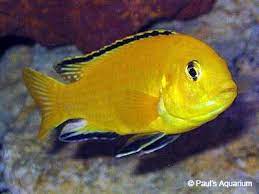
Frontosa aquarium size is very important
Your Frontosa are going to be with you for a long time so make sure you give them a good home and a lot of love. If you have a small tank and figure you’re going to buy juvies and maybe eventually you’re going to buy a bigger aquarium see where it goes. When your fish are big enough that they’re going to need a bigger aquarium you don’t know where you’re going to be in life. You keep the fish in a little longer and that might stunt their growth. You want to give the fish all their chances. You’re better off buying this fish when you’re sure that you’re able to offer them a nice big home. It is the same as buying a baby dog and getting rid of it when it gets too big because you thought you’d have a bigger apartment by then. If you want fish for smaller aquariums check out the mbuna and the Aulonocara

